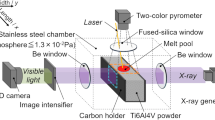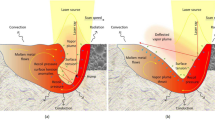Abstract
In laser powder bed fusion (LPBF), defects such as pores or cracks can seriously affect the final part quality and lifetime. Keyhole porosity, being one type of porosity defects in LPBF, results from excessive energy density which may be due to changes in process parameters (namely, laser power and scan speed) and/or result from the part’s geometry and/or hatching strategies. To study the possible occurrence of keyhole pores, experimental work and simulations were carried out for optimum and high volumetric energy density conditions in Ti-6Al-4 V grade 23. By decreasing the scanning speed from 1000 to 500 mm/s for a fixed laser power of 170 W, keyhole porosities are formed and later observed by X-ray computed tomography. Melt pool images are recorded in real-time during the LPBF process by using a high-speed coaxial Near-Infrared (NIR) camera monitoring system. The recorded images are then pre-processed using a set of image processing steps to generate binary images. From the binary images, geometrical features of the melt pool and features that characterize the spatter particle formation and ejection from the melt pool are calculated. The experimental data clearly show spatter patterns in case of keyhole porosity formation at low scan speed. A correlation between number of pores and amount of spatter is observed. Besides the experimental work, a previously developed high fidelity finite volume numerical model was used to simulate the melt pool dynamics with similar process parameters as used during the experiments. Simulation results illustrate and confirm the keyhole porosity formation by decreasing laser scan speed.


















Similar content being viewed by others
References
Li C, Pisignano D, Zhao Y, Xue J (2020) Advances in medical applications of additive manufacturing. Engineering
Abe F, Osakada K, Shiomi M et al (2001) The manufacturing of hard tools from metallic powders by selective laser melting. J Mater Process Technol 111:210–213. https://doi.org/10.1016/S0924-0136(01)00522-2
Leal R, Barreiros FM, Alves L et al (2017) Additive manufacturing tooling for the automotive industry. Int J Adv Manuf Technol 92:1671–1676
Liu R, Wang Z, Sparks T et al (2017) Aerospace applications of laser additive manufacturing. In: Laser additive manufacturing. Elsevier 351–371
Rombouts M, Kruth JP, Froyen L, Mercelis P (2006) Fundamentals of selective laser melting of alloyed steel powders. CIRP Ann Manuf Technol 55:187–192. https://doi.org/10.1016/S0007-8506(07)60395-3
Zhang B, Li Y, Bai Q (2017) Defect formation mechanisms in selective laser melting: a review. Chin J Mech Eng 30:515–527
Khairallah SA, Anderson AT, Rubenchik A, King WE (2016) Laser powder-bed fusion additive manufacturing: Physics of complex melt flow and formation mechanisms of pores, spatter, and denudation zones. Acta Mater 108:36–45
Ranjan R, Yang Y, Ayas C et al (2017) Controlling local overheating in topology optimization for additive manufacturing. In: Proceedings of euspen special interest group meeting: additive manufacturing. Leuven, Belgium
King WE, Barth HD, Castillo VM et al (2014) Observation of keyhole-mode laser melting in laser powder-bed fusion additive manufacturing. J Mater Process Technol 214:2915–2925
Bayat M, Thanki A, Mohanty S et al (2019) Keyhole-induced porosities in Laser-based Powder Bed Fusion (L-PBF) of Ti6Al4V: High-fidelity modelling and experimental validation. Addit Manuf. https://doi.org/10.1016/j.addma.2019.100835
Matsunawa A, Kim J-D, Seto N et al (1998) Dynamics of keyhole and molten pool in laser welding. J Laser Appl 10:247–254
Shrestha S, Chou K (2021) An investigation into melting modes in selective laser melting of Inconel 625 powder: single track geometry and porosity. Int J Adv Manuf Technol 114:3255–3267
Martin AA, Calta NP, Khairallah SA et al (2019) Dynamics of pore formation during laser powder bed fusion additive manufacturing. Nat Commun 10:1–10
Cunningham R, Zhao C, Parab N et al (2019) Keyhole threshold and morphology in laser melting revealed by ultrahigh-speed x-ray imaging. Science 363:849–852
Everton SK, Hirsch M, Stavroulakis PI et al (2016) Review of in-situ process monitoring and in-situ metrology for metal additive manufacturing. Mater Des
Malekipour E, El-Mounayri H (2018) Common defects and contributing parameters in powder bed fusion AM process and their classification for online monitoring and control: a review. Int J Adv Manuf Technol 95:527–550
Clijsters S, Craeghs T, Buls S et al (2014) In situ quality control of the selective laser melting process using a high-speed, real-time melt pool monitoring system. Int J Adv Manuf Technol 75:1089–1101
Goossens LR, Van Hooreweder B (2021) A virtual sensing approach for monitoring melt-pool dimensions using high speed coaxial imaging during laser powder bed fusion of metals. Add Manuf 40:101923
Chen D, Wang P, Pan R et al (2021) Research on in situ monitoring of selective laser melting: a state of the art review. Int J Adv Manuf Technol 113:3121–3138
Matthews MJ, Guss G, Khairallah SA et al (2016) Denudation of metal powder layers in laser powder bed fusion processes. Acta Mater 114:33–42
Ly S, Rubenchik AM, Khairallah SA et al (2017) Metal vapor micro-jet controls material redistribution in laser powder bed fusion additive manufacturing. Sci Rep 7:1–12
Gunenthiram V, Peyre P, Schneider M et al (2018) Experimental analysis of spatter generation and melt-pool behavior during the powder bed laser beam melting process. J Mater Process Technol 251:376–386
Repossini G, Laguzza V, Grasso M, Colosimo BM (2017) On the use of spatter signature for in-situ monitoring of Laser Powder Bed Fusion. Addit Manuf 16:35–48
Thanki A, Goossens L, Mertens R et al (2019) Study of keyhole-porosities in selective laser melting using X-ray computed tomography. 9th Conference on Industrial Computed Tomography 1–7
Thorlabs (2017) Si Switchable Gain Detector User Guide 15
Mikrotron GMBH (2016) High-Speed CMOS CameraEoSens®3CL Datasheet 2
Lim JS (1990) Two-dimensional signal and image processing ph
Lee J-S (1980) Digital image enhancement and noise filtering by use of local statistics. IEEE transactions on pattern analysis and machine intelligence 165–168
Matas J, Chum O, Urban M, Pajdla T (2004) Robust wide-baseline stereo from maximally stable extremal regions. Image Vis Comput 22:761–767
Hu M-K (1962) Visual pattern recognition by moment invariants. IRE transactions on information theory 8:179–187
Cho J-H, Na S-J (2006) Implementation of real-time multiple reflection and Fresnel absorption of laser beam in keyhole. J Phys D Appl Phys 39:5372
Tan W, Bailey NS, Shin YC (2013) Investigation of keyhole plume and molten pool based on a three-dimensional dynamic model with sharp interface formulation. J Phys D Appl Phys 46:55501
Ji Z, Han Q (2020) A novel image feature descriptor for SLM spattering pattern classification using a consumable camera. Int J Adv Manuf Technol 110:2955–2976
Young ZA, Guo Q, Parab ND et al (2020) Types of spatter and their features and formation mechanisms in laser powder bed fusion additive manufacturing process. Add Manuf 36:101438
Wang D, Wu S, Fu F et al (2017) Mechanisms and characteristics of spatter generation in SLM processing and its effect on the properties. Mater Des 117:121–130
Martin AA, Calta NP, Hammons JA et al (2019) Ultrafast dynamics of laser-metal interactions in additive manufacturing alloys captured by in situ X-ray imaging. Mater Today Adv 1:100002
Coen V (2020) An analytical melt pool model for Laser-Powder Bed Fusion An experimental approach for the validation and calibration of a model for Ti6Al4V powder. KULeuven
Acknowledgements
The authors acknowledge Prof. Shoufeng Yang for initial supervision and discussion of this work.
Funding
This research work was funded by research project “PAM2 (Precision Additive Metal Manufacturing)” of the EU Framework Programme for Research and Innovation within Horizon 2020—Marie Skłodowska-Curie Innovative Training Networks under grant agreement No 721383 and by the agency Flanders Innovation & Entrepreneurship (VLAIO) through the Flanders Make project MONICON ICON (HBC.2016.0459).
Author information
Authors and Affiliations
Contributions
Aditi Thanki: Conceptualization, investigation, formal analysis, visualization, validation, writing - original draft. Louca Goossens: Conceptualization, formal analysis, writing - review and editing. Agusmian Partogi Ompusunggu: Conceptualization, supervision, investigation, formal analysis, software, writing - original draft. Mohamad Bayat: Investigation, formal analysis, writing - original draft. Abdellatif Bey-Temsamani: Project management, writing - original draft. Brecht Van Hooreweder: Supervision, resources, writing - review and editing. Jean-Pierre Kruth: Resources, writing - review and editing. Ann Witvrouw: Conceptualization, supervision, funding acquisition, resources, project management, writing - original draft.
Corresponding author
Ethics declarations
Ethics approval
Approved.
Consent to participate
The authors provide consent to participate.
Consent for publication
The authors give consent for publication.
Competing interests
The authors declare no competing interests.
Additional information
Publisher's Note
Springer Nature remains neutral with regard to jurisdictional claims in published maps and institutional affiliations.
Aditi Thanki and Louca Goossens are joint first authors.
Rights and permissions
About this article
Cite this article
Thanki, A., Goossens, L., Ompusunggu, A.P. et al. Melt pool feature analysis using a high-speed coaxial monitoring system for laser powder bed fusion of Ti-6Al-4 V grade 23. Int J Adv Manuf Technol 120, 6497–6514 (2022). https://doi.org/10.1007/s00170-022-09168-2
Received:
Accepted:
Published:
Issue Date:
DOI: https://doi.org/10.1007/s00170-022-09168-2




